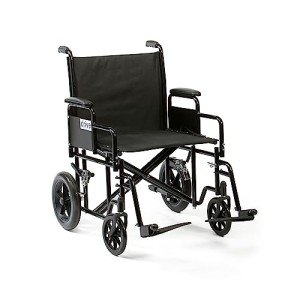Bonus Wide Bariatric Wheelchair With 24" Seat
Frame
Wheelchairs are usually produced in a standard width of 16" (narrow grownup), 18" (standard adult) or 20" (large adult). Nevertheless, lightweight bariatric transport wheelchair need a seat width broader than these standards. These additional wide bariatric wheelchairs are normally fitted by a professional and based upon the user's measurements.

In order to get the most comfy and safe ride for guests, it is very important that wheelchairs are correctly sized. This means that the wheelchair needs to be able to accommodate the user's size while being able to maneuver in tight areas. This is why BriteLift offers tailored cars to transport wheelchair guests. This consists of vans that can securely drive and maneuver big wheelchairs, permitting them to feel safe and comfy in every ride. This is the only way to supply the most effective transport for wheelchair guests.
Seat
Bariatric wheelchairs are bigger than basic wheelchairs and are designed to accommodate individuals who are heavier or larger. This additional broad bariatric wheelchair from Medline includes a 24" seat and a carbon steel frame with rust- and chip-resistant chrome plating. The wheelchair has tool-free push-button adjustable footrests and easy-to-clean vinyl upholstery. It can support approximately 500 lbs.
When selecting the ideal wheelchair width, it is very important to determine the user sitting typically on a flat surface throughout their widest part of the lap which is generally their hips. It is also suggested that you utilize a yardstick rather than a measuring tape as it tends to give a more accurate measurement. If the user will be wearing a winter coat then an extra 2" should be contributed to the measurement of their seat width.
Weight Capacity
A bariatric wheelchair is usually larger and heavier than basic wheelchairs. This is why they need more careful maneuvering. Drivers need to be trained in managing these travelers. Additionally, vehicles require to have adequate space for these chairs as well as ramps and wheelchair lifts. In addition, they require to know how to set up these rides ahead of time.
When deciding on the chair width, it is essential to measure the user's best point in the seat, which is generally the hips. Numerous wheelchair manufacturers also use a yardstick that can be used to aid with this measurement. When measuring an individual's width, it is best to take the measurement directly throughout and not wrap the tape around their hips which can provide an incorrect reading.
Sometimes, the widest part of an individual's thighs might be larger than their hips so this must be taken into factor to consider when choosing the chair width. In these circumstances, it is in some cases essential to add an additional 2" to the chair width.
In basic, the weight capacity of a bariatric wheelchair should not be exceeded under any scenarios or severe injury might result. When utilizing the chair, constantly be sure that it is on a steady and level surface with front casters pointing forward and wheel locks engaged. In addition, never lean or move the center of gravity while being in the chair.
